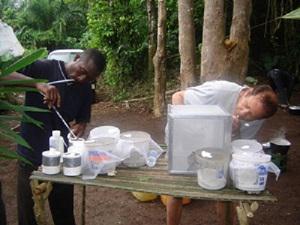Kevin Njabo
Other projects
12 Aug 2010
Correlating Vectors and Diseases in the Rainforests of Cameroon Using Molecular Genetics and Remote Sensing
This project aims to determine vector diversity and use PCR-based detection methods to estimate avian haemosporidian parasites within these vectors. Additionally, we examine the bio-climatic and remote sensing variables that best correlate with vector abundance and disease prevalence.

Kevin and Anton collecting larvae in Ndibi. Note the seed eater nest to the left of picture. May 2008.
A multidisciplinary approach (morphological and molecular) is essential for proper identification of vectors as well as to improve our knowledge on their epidemiological role and transmission biology. The project consists of two major components. The first will involve remote sensing modelling (based of previous results) to identify regions of mature forest and human disturbed areas for intensive field sampling (trapping of vectors with appropriate trapping techniques and preparing of voucher samples).

Getting mosquitoes from CDC traps - Ndibi May 2008.
The second part consists of data analyses (vector identification and blood meal analyses through PCR, microscopy, etc) and inputting field data (presence/absence) into the remote sensing models. The models will be used to predict prevalence and thus provide information about changes in temperature, rainfall, forest fragmentation and greenness over a longitudinal time frame as well as data for cross sectional comparison between habitat types.